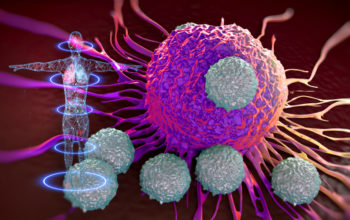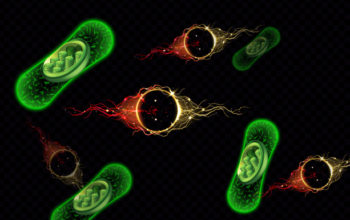
Date: 28th May 2021
Tau is a protein that helps stabilise the internal skeleton of neurons in the brain. However, accumulation of pathological tau in the synapses is an early event in Alzheimer’s disease (AD) and is correlated with cognitive decline in patient with AD. Now, researchers raise the possibility of a new approach to removing the toxic tau protein in Alzheimer’s by enhancing the activity of proteasomes.
Alzheimer’s disease (AD) is the most common cause of dementia, affecting ~50 million worldwide. Whilst medications to alleviate symptoms are now available, ones that modify disease progression are currently lacking. Part of the AD pathology is an abnormal build up of hyperphosphorylated tau protein, which form ‘tau tangles’ causing the internal skeleton of neurons to fall apart, transmission of signals between neurons to fail, and ultimately leads to cell death. In particular, tau accumulates in postsynaptic compartments and presynaptic terminals. As cognitive decline in Alzheimer’s is closely linked to the levels of tau in the brain, researchers are exploring a variety of methods of targeting tau. Although, to date disease halting therapies or treatments have remained elusive and none are currently approved for use.
Now, researchers at Columbia University Irving Medical Center, US, University College London, UK, and Hoshi University, Japan, led by Natura Myeku have discovered that pathological tau protein accumulation occurs on one side the synapse – in postsynaptic compartments. To combat tau accumulation they stimulated PAC1 receptors using the receptor’s ligand. This resulted in increased PKA-dependent proteasome activity which facilitated a reduction of synaptic tau, and improved cognitive performance in AD-mice.
Targeting toxic tau in the specific neuronal compartments reported to accumulate tau in the early stages of AD, could be a safer strategy to prevent tau aggregation and the progressive decline in cognition, rather than targeting all tau protein. To start, the team wanted to determine the spatial and temporal distribution of tau species using a mouse model of tauopathy and in human brains. They found that pathological tau accumulated in the postsynaptic compartment in AD brains and furthermore, the tau found here exhibited high seeding activity – which is the ability to recruit and misfold endogenous tau monomers.
To reduce the postsynaptic tau, the team targeted a certain family of receptors that are present mainly on the surface of synapses, concomitant largely with pathological tau. They stimulated the pituitary adenylate cyclase–activating polypeptide (PACAP) type 1 receptors, PAC1R, with a peptide - the ligand to the receptor called PACAP. They hypothesised this should result in an increase in PKA-dependent protease activity and tau clearance. In primary mouse neurons, PACAP treatment did attenuate seed-induced misfolding of endogenous tau upon exposure to tau seeds, suggesting their theory was correct.
The next question was whether this could translate to tau clearance in vivo. Here the team used a mouse model for tauopathy, and administered intracerebroventricular PACAP. They found the brains of treated mice had reduced synaptic tau pathology. A subcellular phospho-tau species usually found in the cytosolic and postsynaptic fraction of the brain was significantly reduced whilst other species of tau were specifically decreased in the pre- and postsynaptic fractions of PACAP-treated animals. Overall, PACAP treatment was also able to reduce abnormally hyperphosphorylated and aggregated tau attenuating tauopathy.
PACAP-induced PKA signalling is expected to be restricted to where PAC1R is present therefore, PACAP treatment should enhance proteasome function predominantly in postsynaptic compartments. To address this the team isolated synaptic and cytosolic 26S proteasomes by affinity purification and found an increase in the activity of synaptic 26S proteasomes via PKA signalling.
Whilst, the treatment showed promise for tau clearance, the team then asked whether PACAP treatment could improve cognitive performance. The AD-mice with early-stage tauopathy were subjected to hippocampal-dependent spatial (learning) memory and declarative (episodic) memory tests. Upon treatment the mice showed a significant reduction in latency and increased long-term memory over the control animals however, their short-term memory remained unchanged.
Conclusions and future applications
The team here have developed an effective therapeutic approach to target the accumulation of tau in the synaptic compartments in the early stages of AD. Using stimulation of PAC1R which activated cAMP/PKA signalling and enhanced proteasome-mediated clearance of tau species, the strategy resulted in improved cognitive performance.
The data here represent a new tactic to treating AD and one the team will be progressing towards clinical trials. However, the current peptide ligand is not a good candidate for translation into humans as it quickly degrades in the body. In fact, they are already investigating an alternative, prucalpride, which stimulates a receptor with similar action as PAC1 but is already approved by the FDA for human use. It may also provide an efficient strategy for other neurogenerative diseases such as Parkinson’s and Huntington’s.
The work here should add to the ongoing efforts to find treatments for AD and reducing levels of tau is promising approach. Recent work has shown that a humanised anti-tau antibody can reduce accumulation of tau pathology although its ability to improve cognitive decline was not assessed. Others are addressing AD from different angles such as depleting circulating B cells which blocked AD manifestation, or targeting the genetic risk factor apolipoprotein E which disrupts lipid homeostasis in astrocytes. The new approach of targeting certain families of receptors that are present mainly on the surface of synapses will be help to drive translational research into finding novel therapies for treating this devastating disease.
For more information please see the press release from Columbia University Irving Medical Center
Schaler, A.W., Runyan, A.M., Clelland, C.L., Sydney, E.J., Fowler, S.L., Figueroa, H.Y., Shioda, S., Santa-Maria, I., Duff, K.E., and Myeku, N. (2021). PAC1 receptor–mediated clearance of tau in postsynaptic compartments attenuates tau pathology in mouse brain. Science Translational Medicine 13, eaba7394.
https://doi.org/10.1126/scitranslmed.aba7394


